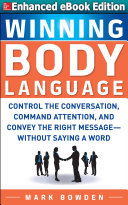

Nonverbal communication is a crucial element of interpersonal interactions. It encompasses facial expressions, gestures, posture, and eye contact, all of which convey messages beyond spoken words. The book emphasizes that up to 93% of communication is nonverbal, which means that understanding body language can significantly enhance one's ability to connect with others. Effective use of body language can help individuals project confidence, build rapport, and convey sincerity. The author provides practical tips on how to read others' body language and adjust your own to align with your communication goals.
Continue readingTrust is a foundational component of successful relationships, whether personal or professional. The book discusses how body language plays a vital role in establishing trust. For instance, open gestures, consistent eye contact, and a relaxed posture can signal honesty and openness. Conversely, closed-off body language, such as crossed arms or avoiding eye contact, can create barriers and foster distrust. The author offers strategies for cultivating a trustworthy presence through body language, which can lead to more productive interactions and stronger connections.
Continue readingPersuasion is an essential skill in many areas of life, from sales to leadership. The book illustrates how body language can enhance persuasive efforts. For example, mirroring the body language of the person you are trying to persuade can create a sense of rapport and make them more receptive to your message. Additionally, using open and expansive body language can project confidence and credibility, making your arguments more compelling. The author provides insights into the subtleties of body language that can tip the scales in favor of persuasion.
Continue readingBody language is not universal; it varies significantly across cultures. The book highlights the importance of being aware of these differences to avoid misunderstandings. For example, gestures that are considered positive in one culture may be offensive in another. The author encourages readers to educate themselves about the cultural contexts of body language to enhance their communication effectiveness, especially in diverse environments. This understanding can lead to more respectful and productive interactions in both personal and professional settings.
Continue readingLeadership is heavily influenced by nonverbal cues. The book discusses how effective leaders use body language to inspire and motivate their teams. For instance, leaders who maintain an open posture and make direct eye contact can foster a sense of inclusion and engagement among team members. The author emphasizes that leaders should be mindful of their body language, as it can significantly impact team dynamics and overall morale. By mastering body language, leaders can enhance their influence and effectiveness.
Continue readingBeing able to accurately read body language is a skill that can provide valuable insights into others' feelings and intentions. The book outlines various cues to look for, such as micro-expressions, posture, and gestures. Understanding these signals can help individuals navigate social situations more effectively and respond appropriately. The author stresses the importance of considering context and individual differences when interpreting body language, as these factors can influence the meaning behind nonverbal cues.
Continue readingLike any skill, body language can be developed and refined through practice. The book provides exercises and techniques for improving one's body language awareness and effectiveness. This includes practicing in front of a mirror, recording oneself during conversations, and seeking feedback from trusted peers. The author encourages readers to be intentional about their body language and to practice consistently to see improvement. By honing these skills, individuals can enhance their overall communication and interpersonal effectiveness.
Continue reading